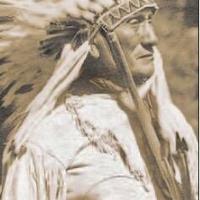The soldier and Indian scout known as I-See-O had a distinctive start in life, which is what led to his distinctive original name.
According to research by Gen. Hugh Scott, who met I-See-O when he was a lieutenant in the U.S. Army, the one-time Kiowa warrior was born about 1849. In the 19th century, Kiowas did not name children until they were a few years old, often to ensure their survival, Scott said in his diary. Scott said I-See-O himself explained that his original name was Tah-bone-mah, which translates as Sees Big Morning Star. He received the name from his father’s brother, who was doing what he could to ensure the sickly 4-year-old would get well and live.
He did and became a noted warrior for the Kiowas, one who once fought against the white invasion before he realized the inevitability of the situation. Historical accounts said he was a mature fighter when he presented himself to the U.S. Army, offering his services as an Indian scout.
According to Scott’s account, Tah-bone-mah said when he first enlisted as a soldier, he took his brother’s name Iseeo, or Plenty of Round Fire Places, which is how military history records his name. He enlisted in the 7th Cavalry around 1889 under the name I-See-O, and Scott said his Kiowa ethnographic knowledge, sign language fluency and diplomacy skills were invaluable. I-See-O was the last surviving member of the Fort Sill detachment of Indian scouts, rising to the rank of sergeant (a rank Scott arranged to make permanent). At the same time, I-See-O rose within the social ranks of his tribe, becoming a keeper of one of the Ten Grandmother Bundles, according to “The Wichita Mountains: Ancient Oasis of the Prairie.”
Accounts of the time said I-See-O was instrumental in persuading Apaches and Kiowas against going to war during the dangerous Ghost Dance movement that warriors participated in to fend off invasion of non-tribal members, and was a key figure in mediating problems with whites and Indians. He was promoted to the rank of Senior Duty Sergeant in the U.S. Army, in recognition of his services during the Ghost Dance era. Scott petitioned to make that rank permanent and I-See-O kept it until his death in 1927.
Action by the U.S. Board on Geographic Names said in November it had accepted a petition to change the name of what has been Tarbone Mountain to Tah-bone-mah Mountain, in recognition of the name I-See-O carried from youth. Federal maps will be updated to reflect that name during normal revision cycles, federal officials said.
Want to reach a local audience and grow your business?
Our website is the perfect platform to connect with engaged readers in your local area.
Whether you're looking for banner ads, sponsored content, or custom promotions, we can tailor a package to meet your needs.
Contact us today to learn more about advertising opportunities!
CONTACT US NOW






